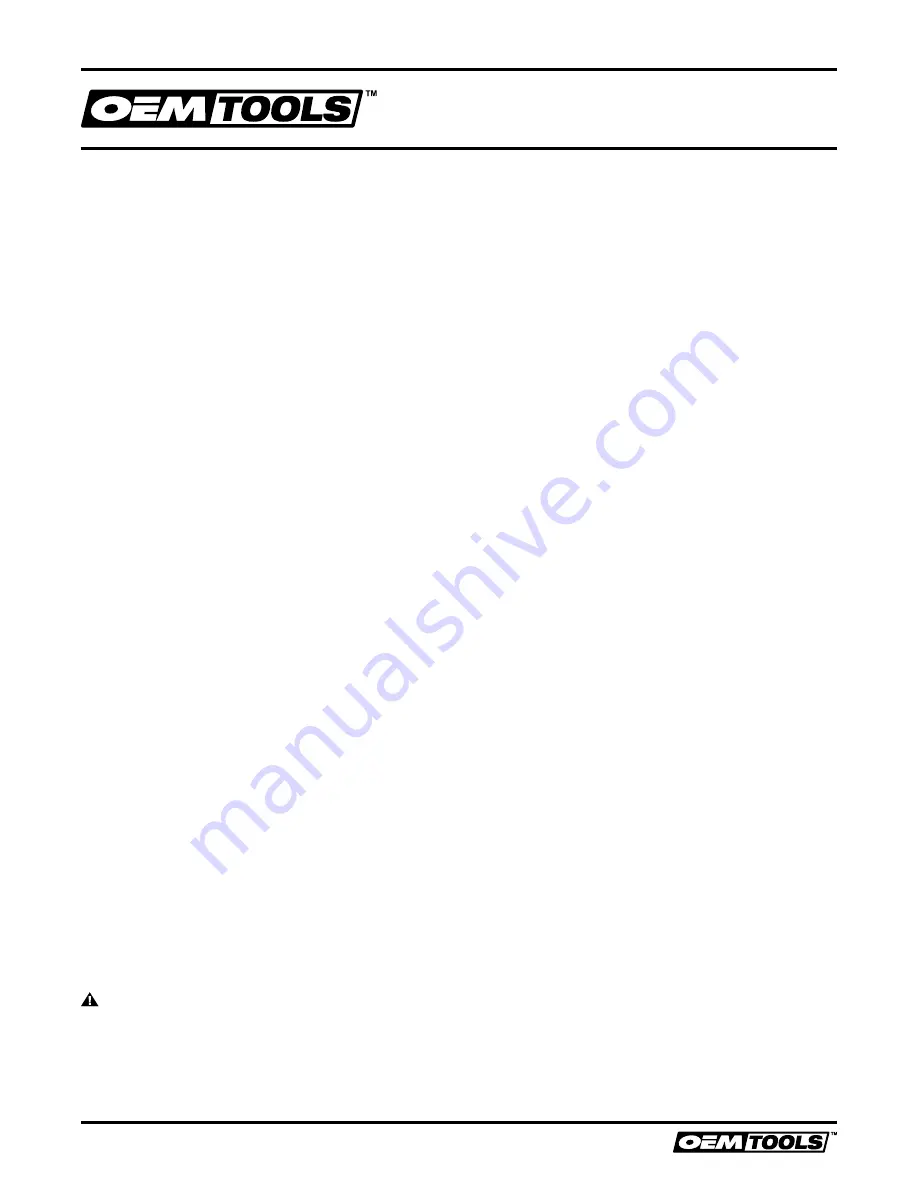
4
Operating Instructions and Parts Manual
24850
11/17
2017 OEMTOOLS
™
20 TON
AIR/HYDRAULIC JACK
TO PREVENT SERIOUS INJURY: DO NOT USE A DAMAGED
OR MALFUNCTIONING JACK
10. If in doubt about the safety of your project, we advise
you to have the work done by a professional familiar
with applicable safety practices.
OPERATION
LIFTING VEHICLE
Always transfer the load to appropriately rated jack stands.
DO NOT work under a load which is supported only by a jack.
Never tie, clamp or disable the lift control valve.
Only attachments and/or adapters supplied by the
manufacturer shall be used.
1. Connect an adequate air source to the air supply inlet.
2. Before first use of this product, pour a teaspoon of
good quality air tool lubricant into the hose quick
coupler plug, then connect it to air source and turn
on the air valve and operate for 3 seconds to evenly
distribute lubricant.
Follow the vehicle manufacturer’s recommended
guidelines for lifting and the location of recommended
lift points.
3. Use the slotted end of the handle to turn the release
valve clockwise until it is firmly closed.
4. Apply the emergency brake and use wheel chocks
to block all wheels to prevent any movement of the
vehicle being lifted.
5. Place the jack into position and adjust the extension
screw as needed.
6. Connect the air quick coupler into the shop air supply
hose quick coupler-female, and then turn on the air
valve.
7. Raise the load to desired height, turn off the air valve
and immediately USE JACK STANDS with adequate
capacity to support the load.
8. When air source is not available, insert the big end
of the handle into the handle bracket, and pump it
manually to raise the load to desired height. Then
immediately transfer the load to appropriate support
devices such as jack stands.
LOWERING VEHICLE
Be sure all tools and personnel are clear before lowering load.
WARNING
:
When work is done, raise load enough
to carefully remove the jack stands. Then SLOWLY and
CAREFULLY lower the load by turning the release valve
counterclockwise (use the slotted end of the handle) in
extremely small increments, then lower the extension screw by
turning it clockwise as needed and remove the jack.
Dangerous dynamic shock loads are created by quickly
opening and closing the release valve when the load
is being lowered. The resulting overload may cause
hydraulic system failure which could cause severe
personal injury and/or property damage.
MAINTENANCE
Important:
Use only good grade hydraulic jack oil. Avoid
mixing different types of fluid and NEVER use brake fluid,
turbine oil, transmission fluid, motor oil or glycerin. Improper
fluid can cause premature failure of the jack and the
potential for sudden and immediate loss of load.
1. Clean the outside of the jack with dry, clean and soft
cloth and periodically lubricate the joints, extension
screw and all moving parts with light oil as needed.
2. When not in use, store the jack in a dry location with
ram (13) and extension screw (13.1) fully lowered.
3. Purge the hydraulic system to eliminate any air in the
system if jack efficiency drops or jack doesn’t work:
a. If manual operation performs poorly, use the slotted
end of the handle to turn the release valve 1-1/2 turns
counterclockwise and remove the oil filler plug (16)
by gently pulling, insert the handle into the handle
bracket and pump it 10 to 15 times, then replace the
filler plug.
b. If air operation performs poorly, connect the air
inlet fitting to air source, use the slotted end of
the handle to turn the release valve 1-1/2 turns
counterclockwise and remove the oil filler plug
(16) by gently pulling, turn on the air valve to let
the pump work for one minute, then replace the
filler plug.
4. Check the hydraulic oil: place the jack in an upright
position, completely lower the ram and remove the
filler plug, if it is not adequate, fill with high quality
hydraulic jack oil to the lower rim of the fill hole, purge
away air from the hydraulic system as described
above, top off with more hydraulic oil, then replace the
filler plug.
5. For best performance and longest life, replace the
complete jack oil at least once per year: With the ram
fully lowered, remove the oil filler plug, lay the jack on
its side and drain the oil into a suitable container, then
fill with high quality hydraulic jack oil as described
above, reinstall the filler plug.
NOTE: Dispose of hydraulic oil in accordance with local
regulations.
Summary of Contents for 24850
Page 8: ......


























